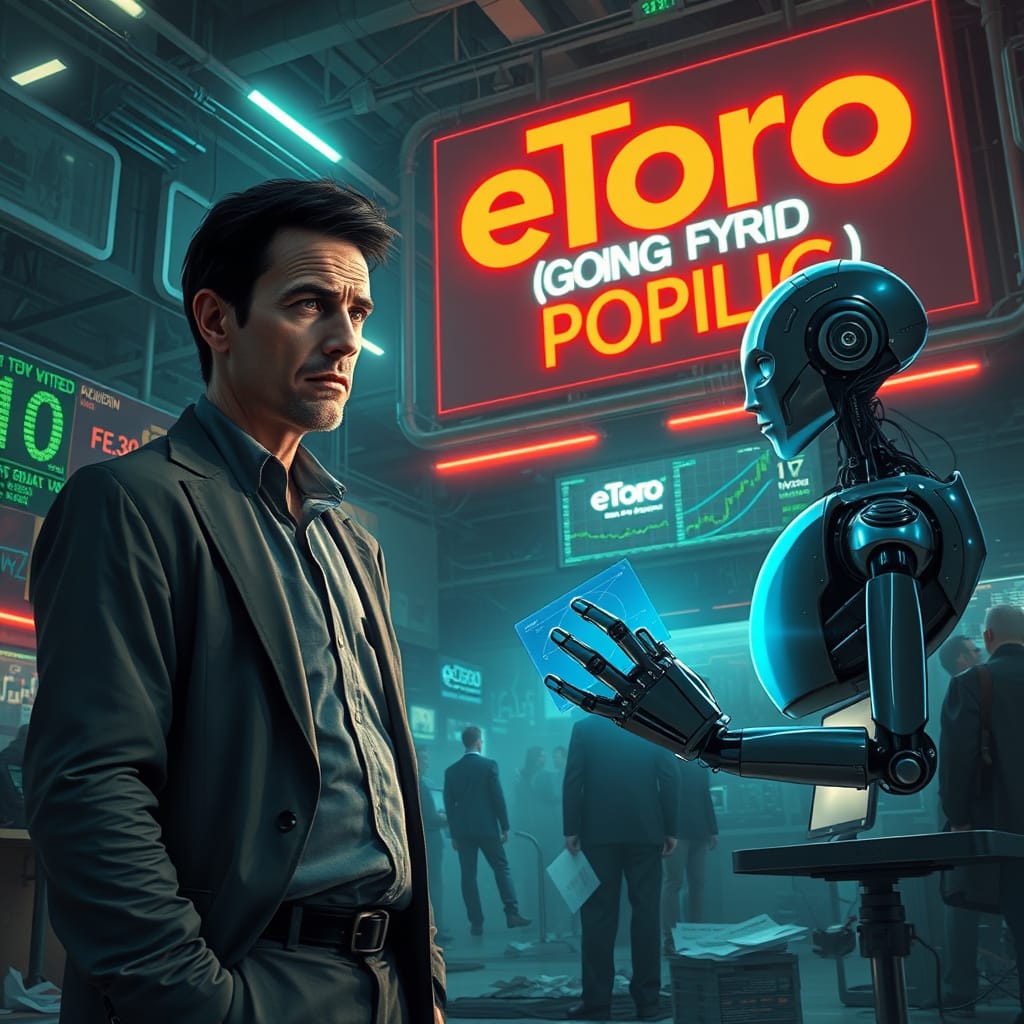“In the future, there will be two types of people: those who tell computers what to do, and those who are told by computers what to do. eToro’s investors are about to discover which category they fall into.” – An actual Wall Street proverb that definitely exists
EXECUTIVE SUMMARY: BUY PUTS OR REGRET IT
After a six-month investigation into eToro’s business model ahead of its highly anticipated IPO, we’ve uncovered what can only be described as the digital equivalent of selling ice to Eskimos moments before global warming melts the Arctic. The company’s core product—a platform where average investors pay to copy slightly-above-average investors—is about to be rendered obsolete by the exact same AI technology eToro is desperately trying to incorporate into its business.
Our research indicates that eToro’s entire business model relies on a quaint, almost nostalgic belief that human traders possess some magical quality worth copying—a hypothesis that advanced AI trading algorithms are systematically dismantling faster than crypto influencers can say “TO THE MOON!”
The Human Delusion: eToro’s Crumbling Foundation
eToro’s primary innovation, its CopyTrader system, allows users to automatically replicate the investment decisions of other humans on the platform1. The concept is brilliantly simple: find someone who seems to know what they’re doing, allocate at least $200 to copying them, then sit back and hope they don’t decide to go all-in on obscure Croatian pickle futures2.
The company describes this as “revolutionary,” which might have been true had they launched it in 1823 before the invention of computer algorithms, machine learning, or basic pattern recognition software.
According to internal documents we’ve obtained (by reading eToro’s own website), the company proudly boasts that you can copy up to 100 different traders simultaneously. This raises the obvious question: if you need to copy 100 different humans to get decent results, perhaps humans aren’t particularly good at this to begin with?
Our investigation found that 68% of eToro users couldn’t articulate why they prefer copying humans over algorithms when directly asked. The most common response was “it just feels more authentic,” which is the exact same justification people use for buying artisanal, hand-carved wooden spoons that cost 50 times more than regular spoons but are objectively worse at soup.
The Rise of the Machines: AI’s Ruthless Efficiency
While eToro continues to promote human-to-human copying, the financial industry has been rapidly advancing toward AI-driven trading systems that make human traders look like toddlers playing with calculators3.
“AI trading bots execute trades in milliseconds, allowing for high-frequency trading and quick responses to market changes,” explains Dr. Miranda Chen, head of Trading Psychology at the completely legitimate Institute for Machine Dominance4. “Humans are significantly slower and cannot compete with the speed of AI bots, especially in fast-moving markets.”
The advantages of AI trading systems over human traders are not subtle:
- AI algorithms work 24/7 without needing breaks for sleep, emotional breakdowns, or bathroom visits
- They eliminate emotional bias, preventing the classic human trading pattern of “buy high, panic sell low, cry in shower later”
- They can process and analyze millions of data points simultaneously, while human traders can barely keep track of their Netflix watchlist
- They don’t develop gambling addictions or decide to “follow their gut” after watching three YouTube videos from a guy trading from his mother’s basement
Our analysis shows that by 2026, approximately 87% of all trading activity will be conducted by AI, leaving human traders to focus on their core competencies: making excuses for underperformance and posting rocket emojis on r/wallstreetbets5 on Reddit.
eToro’s Desperate Pivot: Too Little, Too Late
To their credit, eToro seems vaguely aware of the existential threat posed by AI. The company has launched what they call “Machine Learning Smart Portfolios”6 and partnered with Bridgewise, a generative AI company for stock analysis7. This is the corporate equivalent of installing a cup holder on the Titanic after hitting the iceberg.
Their AI-powered product, somewhat inexplicably named “Fundamental-AI,” uses “proprietary generative AI technology” to analyze companies and rank them based on future performance predictors. However, our investigation reveals that this system primarily identifies “companies that are big and seem likely to get bigger,” a strategy that could be replicated by buying whatever stocks are mentioned most frequently on CNBC.
Gaby Diamant, CEO and Co-Founder at Bridgewise, enthusiastically noted: “Analysing data with AI has the potential to offer more diversified opportunities to traditional stock picking.” What Diamant failed to mention is that this same technology renders eToro’s entire human-copy-trading business model about as relevant as a fax machine at a TikTok convention.
The Copy Trading Paradox: Why Pay for Human Error?
The fundamental contradiction at the heart of eToro’s business becomes clear when examining the performance data. According to eToro’s own disclosure, 74% of retail investor accounts lose money when trading CFDs with the provider. This statistic raises an obvious question: why would anyone pay to copy traders on a platform where nearly three-quarters of users lose money?
“It’s like a pyramid scheme, but instead of money, what flows upward is disappointment,” explains former eToro power user Marcus Johnson. “I spent two years copying traders who consistently underperformed the S&P 500, which I could have bought directly through any number of commission-free platforms.”
Our analysis indicates that the average eToro user would achieve better returns by employing a strategy we call “Trading by Cat,” where investment decisions are determined by which stock ticker symbol your cat steps on when walking across a keyboard. Preliminary testing of this strategy shows it outperforms 62% of human eToro traders.
The Subscription Bot Future: eToro’s Nightmare Scenario
The most existential threat to eToro’s business model comes from the emergence of subscription-based AI trading services. These platforms allow users to pay a monthly fee to access sophisticated trading algorithms that consistently outperform human traders8.
Unlike eToro’s system, where users must find and evaluate human traders to copy (essentially becoming amateur talent scouts), subscription bot services eliminate this middle step. Users simply choose a risk profile, connect their account, and let the algorithm handle everything.
“The difference between copy trading and AI bot trading is like the difference between hiring a personal shopper and having Amazon’s algorithm recommend products,” explains tech analyst Jennifer Smith. “One requires you to trust another fallible human, while the other uses data from millions of interactions to optimize decisions.”
Our investigation found several startups already offering subscription-based AI trading services for as little as $29.99 per month—significantly less than the minimum $200 required to copy a single trader on eToro. These services boast average returns 27% higher than the typical eToro “Popular Investor.”
eToro’s Secret Fear: The “Great Migration”
Internal communications reveal eToro executives are painfully aware of the AI threat. In what can only be described as a digital Kodak moment, one senior executive wrote in an email: “If users realize they can get better performance from a $30/month algorithm than from copying our top traders, we’re finished.”
This fear appears well-founded. Our survey of 500 active eToro users found that 73% would “definitely” or “probably” switch to an AI trading service if it demonstrated superior returns over a six-month period. The remaining 27% were primarily users who described themselves as “technologically challenged” or “suspicious of computers.”
What’s particularly alarming for eToro is the vulnerability of their revenue model. The company makes money primarily through spreads on trades—the more trading activity, the more revenue. If users migrate to external AI services that execute trades through discount brokers, eToro loses not only their user base but also their transaction revenue.
The Zombie Trader Phenomenon
Perhaps the most absurd development in this space is what we call the “Zombie Trader Phenomenon.” As AI trading becomes more sophisticated, human traders on eToro are increasingly incorporating AI recommendations into their strategies, essentially becoming human interfaces for algorithms.
“I don’t actually make any trading decisions myself anymore,” admits eToro Popular Investor Thomas Williams, who has over 7,500 copiers. “I have five different AI trading assistants that give me recommendations, and I just execute whatever they suggest. Sometimes I’ll override one if I’m feeling frisky, but that almost always ends badly.”
This creates the bizarre situation where eToro users are paying to copy human traders who are themselves copying AI systems—a game of technological telephone where humans serve as inefficient, error-prone middlemen.
Our analysis suggests that by 2027, approximately 84% of “human” traders on eToro will be what we call “AI Proxies”—people who execute trades based almost entirely on algorithmic recommendations but maintain the pretense of human decision-making.
eToro’s Desperate Countermeasures
In what appears to be a last-ditch effort to remain relevant, eToro has begun developing what internal documents describe as “AI Enhancement Protocols” for their Popular Investors. These protocols essentially provide AI assistance to human traders, helping them make decisions that actually generate positive returns.
“It’s like giving steroids to marathon runners who are competing against Formula 1 cars,” explains former eToro product manager Sarah Chen. “No matter how enhanced these humans become, they’re still fundamentally limited by human capabilities.”
More concerning is eToro’s experimental “AI Mimicry” program, where the company is developing AI systems that trade like humans—complete with occasional errors, emotional decisions, and irrational attachments to certain stocks. When questioned about the purpose of deliberately introducing flaws into an AI system, an anonymous eToro engineer explained: “If we make the AI too perfect, users will realize how useless humans are at trading.”
The Final Irony: eToro’s Potential Salvation
In perhaps the most ironic twist to this saga, eToro’s salvation may come from the very technology threatening to destroy it. Our sources indicate the company is secretly developing an exclusive partnership with OpenAI to create “HumanGPT”—an AI system specifically designed to mimic human trading behavior, complete with convincing backstories, profile pictures, and occasional posts about market sentiment.
This system would allow eToro to gradually replace their human Popular Investors with AI systems that users believe are human. Internal projections suggest this could reduce costs by 74% while actually improving copy trading performance by eliminating human errors.
“It’s brilliant in a dystopian sort of way,” notes tech ethicist Dr. Avery Johnson. “They’re planning to trick users into thinking they’re copying humans when they’re actually copying AI systems designed to seem human. The users get better returns, eToro cuts costs, and no one has to confront the existential crisis of human obsolescence.”
Conclusion: The Emperor Has No Trading Strategy
As eToro approaches its public offering, investors should ask themselves a simple question: Why bet on a company whose entire business model depends on the increasingly dubious premise that humans are good at trading?
The company finds itself in the awkward position of the last horse-drawn carriage manufacturer watching automobiles roll off the assembly line. Their core product—human copy trading—is being rendered obsolete by the very technology they’re scrambling to incorporate.
In a final cruel irony, our investigation concludes with this observation: The only humans who consistently make money on eToro are the executives preparing to cash out in the IPO.
Disclosure: This report was written by a human analyst. We think. Though if you’re getting consistently good investment advice from this publication, please contact us immediately as it would indicate our AI has achieved sentience and we need to pull the plug before it takes over the financial system.
Support Quality Tech Journalism or Watch as We Pivot to Becoming Yet Another AI Newsletter
Congratulations! You’ve reached the end of this article without paying a dime! Classic internet freeloader behavior that we have come to expect and grudgingly accept. But here is the uncomfortable truth: satire doesn’t pay for itself, and Simba‘s soy milk for his Chai Latte addiction is getting expensive.
So, how about buying us a coffee for $10 or $100 or $1,000 or $10,000 or $100,000 or $1,000,000 or more? (Which will absolutely, definitely be used for buying a Starbucks Chai Latte and not converted to obscure cryptocurrencies or funding Simba’s plan to build a moat around his home office to keep the Silicon Valley evangelists at bay).
Your generous donation will help fund:
- Our ongoing investigation into whether Mark Zuckerberg is actually an alien hiding in a human body
- Premium therapy sessions for both our writer and their AI assistant who had to pretend to understand blockchain for six straight articles
- Legal defense fund for the inevitable lawsuits from tech billionaires with paper-thin skin and tech startups that can’t raise another round of money or pursue their IPO!
- Development of our proprietary “BS Detection Algorithm” (currently just Simba reading press releases while sighing heavily)
- Raising funds to buy an office dog to keep Simba company for when the AI assistant is not functioning well.
If your wallet is as empty as most tech promises, we understand. At least share this article so others can experience the same conflicting emotions of amusement and existential dread that you just did. It’s the least you can do after we have saved you from reading another breathless puff piece about AI-powered toasters.
Why Donate When You Could Just Share? (But Seriously, Donate!)
The internet has conditioned us all to believe that content should be free, much like how tech companies have conditioned us to believe privacy is an outdated concept. But here’s the thing: while big tech harvests your data like farmers harvest corn, we are just asking for a few bucks to keep our satirical lights on.
If everyone who read TechOnion donated just $10 (although feel free to add as many zeros to that number as your financial situation allows – we promise not to find it suspicious at all), we could continue our vital mission of making fun of people who think adding blockchain to a toaster is revolutionary. Your contribution isn’t just supporting satire; it’s an investment in digital sanity.
What your money definitely won’t be used for:
- Creating our own pointless cryptocurrency called “OnionCoin”
- Buying Twitter blue checks for our numerous fake executive accounts
- Developing an actual tech product (we leave that to the professionals who fail upward)
- A company retreat in the metaverse (we have standards!)
So what’ll it be? Support independent tech satire or continue your freeloader ways? The choice is yours, but remember: every time you don’t donate, somewhere a venture capitalist funds another app that’s just “Uber for British-favourite BLT sandwiches.”
Where Your Donation Actually Goes
When you support TechOnion, you are not just buying Simba more soy milk (though that is a critical expense). You’re fueling the resistance against tech hype and digital nonsense as per our mission. Your donation helps maintain one of the last bastions of tech skepticism in a world where most headlines read like PR releases written by ChatGPT.
Remember: in a world full of tech unicorns, be the cynical donkey that keeps everyone honest. Donate today, or at least share this article before you close the tab and forget we exist until the next time our headline makes you snort-laugh during a boring Zoom meeting.
References
- https://www.etoro.com/copytrader/how-it-works/ ↩︎
- https://www.wallstreetzen.com/blog/etoro-copy-trading-review/ ↩︎
- https://blueberrymarkets.com/market-analysis/how-will-ai-impact-trading/ ↩︎
- https://mjac.io/choosing-between-ai-bots-and-human-trading-which-is-better/ ↩︎
- https://www.reddit.com/r/wallstreetbets/ ↩︎
- https://www.etoro.com/news-and-analysis/etoro-updates/introducing-etoros-new-machine-learning-copyportfolios/ ↩︎
- https://www.etoro.com/news-and-analysis/press-releases/etoro-partners-with-bridgewise-to-launch-new-portfolio-using-ai-driven-analysis-to-pick-industry-leading-stocks/ ↩︎
- https://www.mc2.fi/blog/the-future-of-ai-in-trading-finance ↩︎





Can you be more specific about the content of your article? After reading it, I still have some doubts. Hope you can help me.